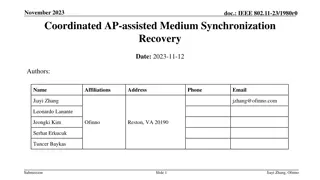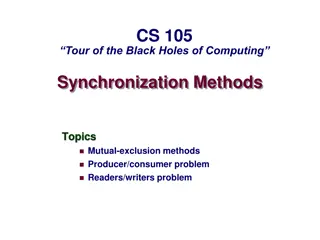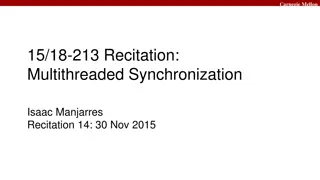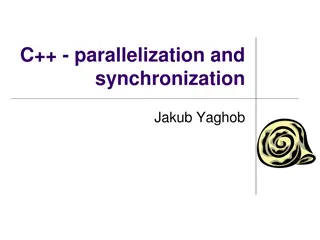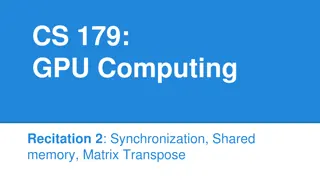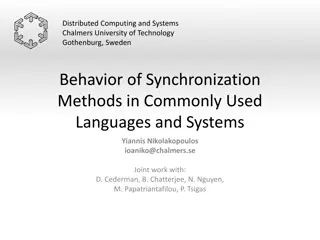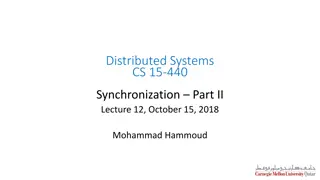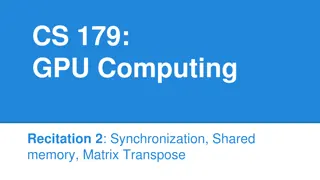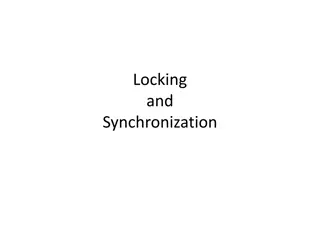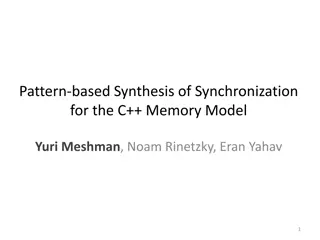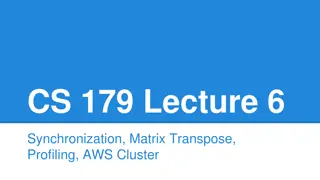
Synchronization Mechanisms in Computer Systems
Explore various synchronization techniques such as locks, barriers, and hardware primitives in computer science. Learn about mutual exclusion, event synchronization, global barriers, and more in this detailed study on synchronization in computer systems.
Download Presentation

Please find below an Image/Link to download the presentation.
The content on the website is provided AS IS for your information and personal use only. It may not be sold, licensed, or shared on other websites without obtaining consent from the author. If you encounter any issues during the download, it is possible that the publisher has removed the file from their server.
You are allowed to download the files provided on this website for personal or commercial use, subject to the condition that they are used lawfully. All files are the property of their respective owners.
The content on the website is provided AS IS for your information and personal use only. It may not be sold, licensed, or shared on other websites without obtaining consent from the author.
E N D
Presentation Transcript
Synchronization 15-740 16 Feb 2017 Topics Locks Barriers Hardware primitives
Types of Synchronization Mutual Exclusion Locks Event Synchronization Global or group-based (barriers) Point-to-point (producer-Consumer) 2 740 S17
Simple Producer-Consumer Example xflagp xflagp flag Producer xdatap Consumer xdatap data Memory Initially flag=0 sd xdata, (xdatap) li xflag, 1 sd xflag, (xflagp) spin: ld xflag, (xflagp) beqz xflag, spin ld xdata, (xdatap) Is this correct? 3 740 S17
Memory Model Sequential ISA only specifies that each processor sees its own memory operations in program order Memory model describes what values can be returned by load instructions across multiple threads 4 740 S17 4
Simple Producer-Consumer Example flag Producer Consumer data Initially flag=0 sd xdata, (xdatap) li xflag, 1 sd xflag, (xflagp) spin: ld xflag, (xflagp) beqz xflag, spin ld xdata, (xdatap) Can consumer read flag=1 before data written by producer? 5 740 S17 5
Sequential Consistency A Memory Model P P P P P P M A system is sequentially consistent if the result of any execution is the same as if the operations of all the processors were executed in some sequential order, and the operations of each individual processor appear in the order specified by the program Leslie Lamport Sequential Consistency = arbitrary order-preserving interleaving of memory references of sequential programs 6 740 S17
Simple Producer-Consumer Example flag Producer Consumer data Initially flag =0 sd xdata, (xdatap) li xflag, 1 sd xflag, (xflagp) spin: ld xflag, (xflagp) beqz xflag, spin ld xdata, (xdatap) Dependencies from sequential ISA Dependencies added by sequentially consistent memory model 7 740 S17
Implementing SC in hardware Only a few commercial systems implemented SC Neither x86 nor ARM are SC Requires either severe performance penalty Wait for stores to complete before issuing new store Or, complex hardware Speculatively issue loads but squash if memory inconsistency with later-issued store discovered (MIPS R10K) 8 740 S17
Software reorders too! //Producer code *datap = x/y; *flagp = 1; //Consumer code while (!*flagp) ; d = *datap; Compiler can reorder/remove memory operations unless made aware of memory model Instruction scheduling, move loads before stores if to different address Register allocation, cache load value in register, don t check memory Prohibiting these optimizations would result in very poor performance 9 740 S17
Relaxed Memory Models Not all dependencies assumed by SC are supported, and software has to explicitly insert additional dependencies were needed Which dependencies are dropped depends on the particular memory model IBM370, TSO, PSO, WO, PC, Alpha, RMO, How to introduce needed dependencies varies by system Explicit FENCE instructions (sometimes called sync or memory barrier instructions) Implicit effects of atomic memory instructions Programmers supposed to work with this???? 10 740 S17
Fences in Producer-Consumer Ex flag Producer Consumer data Initially flag =0 sd xdata, (xdatap) li xflag, 1 fence.w.w // Write-Write // fence sd xflag, (xflagp) spin: ld xflag, (xflagp) beqz xflag, spin fence.r.r // Read-Read // fence ld xdata, (xdatap) 11 740 S17
Simple Mutual-Exclusion Example Thread 1 xdatap Thread 2 xdatap data Memory // Both threads execute: ld xdata, (xdatap) add xdata, 1 sd xdata, (xdatap) Is this correct? 12 740 S17
MutEx with Ld/St (+SC) A protocol based on two shared variables c1 and c2. Initially, both c1 and c2 are 0 (not busy) Process 2 ... c2=1; L: if c1=1 then go to L < critical section> c2=0; Process 1 ... c1=1; L: if c2=1 then go to L < critical section> c1=0; What is wrong? Deadlock! 13 740 S17
Mutual Exclusion: second attempt To avoid deadlock, let a process give up the reservation (i.e. Process 1 sets c1 to 0) while waiting. Process 1 ... L: c1=1; if c2=1 then { c1=0; go to L} < critical section> c1=0 Process 2 ... L: c2=1; if c1=1 then { c2=0; go to L} < critical section> c2=0 Deadlock is not possible but with a low probability a livelock may occur. An unlucky process may never get to enter the critical section starvation 14 740 S17
A Protocol for Mutual Exclusion T. Dekker, 1966 A protocol based on 3 shared variables c1, c2 and turn. Initially, both c1 and c2 are 0 (not busy) Process 1 ... c1=1; turn = 1; L: if c2=1 & turn=1 < critical section> c1=0; Process 2 ... c2=1; turn = 2; L: if c1=1 & turn=2 < critical section> c2=0; then go to L then go to L turn = i ensures that only process i can wait variables c1 and c2 ensure mutual exclusion Solution for n processes was given by Dijkstra and is quite tricky! 15 740 S17
Components of Mutual Exclusion Acquire How to get into critical section Wait algorithm What to do if acquire fails Release algorithm How to let next thread into critical section Can be implemented using LD/ST, but Need fences in weaker models Doesn t scale + complex 16 740 S17
Busy Waiting vs. Blocking Threads spin in above algorithm if acquire fails Busy-waiting is preferable when: scheduling overhead is larger than expected wait time schedule-based blocking is inappropriate (eg, OS) Blocking is preferable when: Long wait time & other useful work to be done Especially if core is needed to release the lock! Hybrid spin-then-block often used! 17 740 S17
Need Atomic Primitive! Test&Set set to 1 and return old value Swap atomic swap of register + memory location Fetch&Op Fetch&Increment, Fetch&Add, Compare&Swap if *mem == A then *mem == B Load-linked/Store-Conditional (LL/SC) LL: return value of an address SC: if (value of address unchanged) then store value to address return 1 else return 0 18 endif 740 S17
Lock for Mutual-Exclusion Example xlockp xlockp lock Thread 1 xdatap Thread 2 xdatap data Memory // Both threads execute: li xone, 1 spin: amoswap xlock, xone, (xlockp) bnez xlock, spin ld xdata, (xdatap) add xdata, 1 sd xdata, (xdatap) sd x0, (xlockp) Acquire Lock Critical Section Release Lock Assumes SC memory model 19 740 S17
Mutual-Exclusion with Relaxed MM xlockp xlockp lock Thread 1 xdatap Thread 2 xdatap data Memory // Both threads execute: li xone, 1 spin: amoswap xlock, xone, (xlockp) bnez xlock, spin fence.r.r ld xdata, (xdatap) add xdata, 1 sd xdata, (xdatap) fence.w.w Acquire Lock Critical Section Release Lock 20 sd x0, (xlockp) 740 S17
Mutual Exclusion with Swap lock: spin: li r1, #1 amoswap r2, r1, (lockaddr) bnez r2, spin ret unlock: st (lockaddr), #0 ret 21 740 S17
Test&Set based lock lock: t&s bnez r1, lock ret r1, (lockaddr) unlock: st ret (lockaddr), #0 22 740 S17
Mutual-Exclusion with LL/SC lock: LL R1, (lockaddr) BNEZ LOCK ADD R1, R1, #1 SC R1, (lockaddr) BEQZ LOCK RET unlock: ST (lockaddr), #0 RET LL/SC are a flexible way to implement many atomic operations 23 740 S17
Implementing Fetch&Op Load Linked/Store Conditional reg1, location/* LL location to reg1 */ bnz reg1, lock op reg2, reg1, value sc location, reg2/* SC reg2 into location*/ beqz reg2, lock ret lock: ll unlock: /* check if location locked*/ /* if failed, start again */ /* write 0 to location */ st ret location, #0 24 740 S17
Implementing Atomics Lock cache line or entire cache Get exclusive permissions Don t respond to invalidates Do operation (eg, add in Fetch&Add) Resume normal operation 25 740 S17
Implementing LL/SC In invalidation-based directory protocol SC requests exclusive permissions If requestor is still sharer, success Otherwise, fail and don t get permissions (invalidate in flight) Add link register that stores address of LL Invalidated upon coherence / eviction Only safe to use register-register instructions between LL/SC! (Why?) 26 740 S17
How to Evaluate? Scalability Network load Single-processor latency Space Requirements Fairness Required atomic operations Sensitivity to co-scheduling 27 740 S17
T&S Lock Performance Code: lock; delay(c); unlock; Same total no. of lock calls as p increases; measure time per transfer 20 Test&set, c = 0 Test&set, exponential backof f, c = 3.64 Test&set, exponential backof f, c = 0 Ideal 18 16 14 12 Time ( s) 10 8 6 4 2 0 3 5 7 9 11 13 15 Number of processors 28 740 S17
Evaluation of Test&Set based lock lock: t&s bnz ret register, location lock unlock: Scalability Network load Single-processor latency Space Requirements Fairness Required atomic operations Sensitivity to co-scheduling st ret location, #0 poor large good good poor T&S good? 29 740 S17
Test and Test and Set A: while (lock != free); if (test&set(lock) == free) { critical section; } else goto A; (+) spinning happens in cache (-) can still generate a lot of traffic when many processors go to do test&set 30 740 S17
Test and Set with Backoff Upon failure, delay for a while before retrying either constant delay or exponential backoff Tradeoffs: (+) much less network traffic (-) exponential backoff can cause starvation for high-contention locks new requestors back off for shorter times But exponential found to work best in practice 31 740 S17
T&S Lock Performance Code: lock; delay(c); unlock; Same total no. of lock calls as p increases; measure time per transfer 20 Test&set, c = 0 Test&set, exponential backof f, c = 3.64 Test&set, exponential backof f, c = 0 Ideal 18 16 14 12 Time ( s) 10 8 6 4 2 0 3 5 7 9 11 13 15 Number of processors 32 740 S17
Test and Set with Update Test and Set sends updates to processors that cache the lock Tradeoffs: (+) good for bus-based machines (-) still lots of traffic on distributed networks Main problem with test&set-based schemes: a lock release causes all waiters to try to get the lock, using a test&set to try to get it. 33 740 S17
Ticket Lock (fetch&incr based) Two counters: next_ticket (number of requestors) now_serving (number of releases that have happened) Algorithm: ticket = F&I(next_ticket) while (ticket != now_serving) delay(x) // I have lock now_serving++ Acquire Lock Critical Section Release Lock 34 740 S17
Ticket Lock (fetch&incr based) Two counters: next_ticket (number of requestors) now_serving (number of releases that have happened) Algorithm: ticket = F&I(next_ticket) while (ticket != now_serving) delay(x); // I have lock now_serving++; What delay to use? Not exponential! Can use now_serving-next_ticket. 35 740 S17
Ticket Lock (fetch&incr based) Two counters: next_ticket (number of requestors) now_serving (number of releases that have happened) Algorithm: ticket = F&I(next_ticket) while (ticket != now_serving) delay(x); // I have lock now_serving++; (+) guaranteed FIFO order; no starvation possible (+) latency can be low if fetch&incr is cacheable (+) traffic can be quite low, but contention on polling (-) but traffic is not guaranteed to be O(1) per lock acquire 36 740 S17
Array-Based Queueing Locks Every process spins on a unique location, rather than on a single now_serving counter next-slot Lock Wait Wait Wait Wait my-slot = F&I(next-slot) my-slot = my-slot % num_procs while (slots[my-slot] == Wait); slots[my-slot] = Wait; critical section; slots[(my-slot+1)%num_procs] = Lock; Acquire Lock Critical Section Release Lock 37 740 S17
List-Base Queueing Locks (MCS) All other good things + O(1) traffic even without coherent caches (spin locally) Uses compare&swap to build linked lists in software Locally-allocated flag per list node to spin on Can work with fetch&store, but loses FIFO guarantee Tradeoffs: (+) less storage than array-based locks (+) O(1) traffic even without coherent caches (-) compare&swap not easy to implement (three operands) 38 740 S17
Synchronization (cont): Barriers 21 Feb 2017 39 740 S17
Barrier Single operation: wait until P threads all reach synchronization point Barrier Barrier 40 740 S17
Barriers We will discuss five barriers: centralized software combining tree dissemination barrier tournament barrier MCS tree-based barrier 41 740 S17
Barrier Criteria Length of critical path Total network communication Space requirements Atomic operation requirements 42 740 S17
Critical Path Length Analysis assumes independent parallel network paths available May not apply in some systems Eg, communication serializes on bus In this case, total communication dominates critical path More generally, network contention can lengthen critical path 43 740 S17
Centralized Barrier Basic idea: Notify a single shared counter when you arrive Poll that shared location until all have arrived Implemented using atomic fetch & op on counter 44 740 S17
Centralized Barrier 1st attempt int counter = 1; void barrier(P) { if (fetch_and_increment(&counter) == P) { counter = 1; } else { while (counter != 1) { /* spin */ } } } Is this implementation correct? 45 740 S17
Centralized Barrier Basic idea: Notify a single shared counter when you arrive Poll that shared location until all have arrived Implemented using atomic fetch & decrement on counter Simple solution requires polling/spinning twice: First to ensure that all procs have left previous barrier Second to ensure that all procs have arrived at current barrier 46 740 S17
Centralized Barrier 2nd attempt int enter = 1; // allocate on diff cache lines int exit = 1; void barrier(P) { if (fetch_and_increment(&enter) == P) { // enter barrier enter = 1; } else { while (enter != 1) { /* spin */ } } if (fetch_and_increment(&exit) == P) { // exit barrier exit = 1; } else { while (exit != 1) { /* spin */ } } } Do we need to count to P twice? 47 740 S17
Centralized Barrier Basic idea: Notify a single shared counter when you arrive Poll that shared location until all have arrived Implemented using atomic fetch & decrement on counter Simple solution requires polling/spinning twice: First to ensure that all procs have left previous barrier Second to ensure that all procs have arrived at current barrier Avoid spinning with sense reversal 48 740 S17
Centralized Barrier Final version int counter = 1; bool sense = false; void barrier(P) { bool local_sense = ! sense; if (fetch_and_increment(&counter) == P) { counter = 1; sense = local_sense; } else { while (sense != local_sense) { /* spin */ } } } 49 740 S17
Centralized Barrier Analysis Remote spinning on single shared location Maybe OK on broadcast-based coherent systems, spinning traffic on non-coherent or directory-based systems can be unacceptable O(P) operations on critical path O(1) space O(P) best-case traffic, but O(P^2) or even unbounded in practice (why?) How about exponential backoff? 50 740 S17


